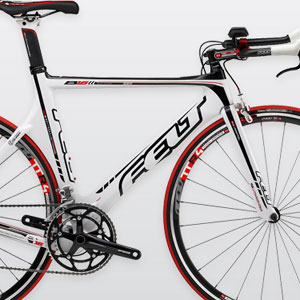
At the 2006 edition of Interbike, the cycling world's important North American trade show, Felt unveiled a line of bicycles that remains the biggest step forward, one year to the next, that any brand has made in triathlon at least since the turn of the decade. Felt went from a disastrous fitting bike line to a spectacular fitting bike line, such frames also exhibiting the sex appeal and functionality to work well both for triathletes and for the riders on what is now Team Garmin-Slipstream.
What shoe makers call a "last" and what car makers call a "chassis" is in Felt's case a "frame" that forms the basis for almost its entire tri bike line. Save for the S32, all the other tri bikes Felt makes—eight in all—pop out of this one size run of molds. Felt places a different modulus carbon, or affixes its Bayonet fork and, presto, another bike model. This has become a common theme (consider QR's Seduza, Caliente and Lucero) and no company does it more artfully than Felt.
If you want to hop aboard a frame popping out of this Felt mold, but you're on a restricted budget, the B16 is your recession buster. The nice thing about a mold that's been around for a couple of seasons, if there were any problems with shifting, clearances, straightness, they'll probably have been sorted by now. So what you have is this very nice handling, extremely-well fitting frame, with a "lesser" fork to suit the price point, and you're off and running.
The price Felt hits with the B16 is $1999, the same as QR's Seduza, and this is a discount from last year's MSRP of $2300 for this bike. Few if any all-carbon complete tri bikes come in underneath that price.
Felt outfits the B16 with a Shimano 105 front and rear derailleur, and a "Shimano" chain and cassette which can mean something so low on the Shimano totem pole these iterations don't even bear model names. But that's okay, because nothing Shimano makes is that cheesy and, besides, these are "consumables," like tires and handlebar tape. Just know that you'll "consume" this chain and cassette a bit more quickly, so be prepared to replace each in a year or so.
The cranks are FSA Gossamer Mega EXO, an acceptable but not spectacular spec choice. This is a slight downgrade from last year's Gossamer TT Mega EXO. Then again, is it an downgrade? As far as I can tell, the TT Mega EXO has as its primary feature larger chainrings, and, most triathletes are heading in the other direction—peeling off their 130mm bolt pattern cranks in favor of 110mm compacts. So, for all practical purposes, Felt did its customers a favor by "downgrading" to the crank on the 2010 model.
An awful lot of the B16 is spec'd with Felt's proprietary parts. Rims, hubs, saddle, aerobars, stem, pursuit bar, are all Felt-branded, and the brake calipers exhibit no brand. I'm not against house brands, I'm in favor of them, because a complete bike seller should enjoy the freedom to design the parts he feels he needs to make his bike work as he think it ought.
Nevertheless, there is always the temptation to use low-cost items churned out by no-name factories, and retailers and end-users must always hold brands accountable for parts that bear the house brand logo. Are aerobars, saddles, forks, stems, handlebars, wheels and wheel parts, as commodotized and ubiquitious as nuts and bolts? No, they're not.
I'm a fan of Felt's Devox aerobars, it's done a very nice job with them. And, Felt has done well with its tri saddle. The B16 gets the saddle, but not the Devox bars. These are lower-end bars and you may have to change them out for something preferable. Still, at $1999 you have the luxury to do so and still end up with a very nice bike at a great price.
Felt does one thing no other major tri brand does: it makes its smallest two sizes with 650c wheels. If you're shorter than 5'7", go on our Slowtwitch reader forum and ask folks of a similar height whether they'd be willing to give up their 650c bikes. Four times out of five, you'll find you couldn't blast them off those wheels with a stick of dynamite. Felt caters to these shorter riders with well-conceived bikes that make the 48cm and 50cm sizes among the very best in the size run.
You've got an option you didn't have last year. For $500 more you can move to the B14, a model squeezed into the lineup, between the 12 and the 16. You don't get that much more bike for the extra money—Ultegra derailleurs, a slightly different wheelset, and those TT Mega EXO cranks you'll probably end up pulling off the bike. Best stick with the B16.
As a consumer, I'm always drawn to that place in a company's lineup where they're really straining to make a margin—where the company's bean counters wince as they look at how much money they're not making on an item, and just shrug their shoulders and say, "We'll make back our margin on the other models." That's the soft spot where, as a consumer, I figure I'll get my best value. If I was to guess, I'd say the B16 is that soft spot. This might be the most Felt for the least dollars.


